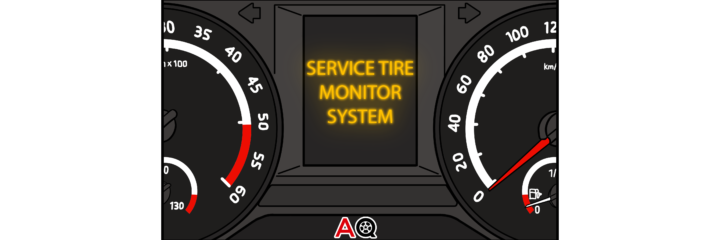The Service Tire Monitoring System or Tire Pressure Monitoring Sensor (TMPS) are sensors located at each wheel of your vehicle to keep track of tire pressure. So, every time you get a “Service Tire Monitor System” message, it means your tire pressure is either low or high.
But more often than not, the message has nothing to do with your tire pressure but rather a signal that one of the sensors has developed a fault or wrongly conveying data to the ECU (Electronic Control Unit).
The TPMS comprises non-replaceable batteries that will be eventually exhausted after a few years, necessitating the need to replace the sensor since you can’t just swap out the battery. Dead batteries are by far the most common reason to replace the TPMS. The batteries in a tire pressure sensor should last at least 5-10 years, depending on the model.
Where Is the Service Tire Monitor System Located?
You can find the sensor (remember, the Service Tire Monitoring System is made up of sensors) for each tire on the inside of your rim’s valve stem or on the rim itself on the other side of the valve stem. For the latter, the sensors are placed on a band that wraps around the rim.
It is advisable to check your tires to ensure adequate Pound-force per Square Inch (PSI) before installing a new sensor and then double-check that sensor afterward.
How Do I Check My Sensors?
With a TPMS Relearn Tool, inspecting the sensor is inexpensive and straightforward. The device thoroughly examines the condition of your TPMS sensor, determining whether it is in good working condition or not. With a TPMS Relearn Tool, you can be confident that your tires have the correct inflation level and that you receive the “Service Tire Monitor System” or “Tire Pressure Monitoring Sensor” message when you should.
Indications of a Bad Tire Pressure Monitoring System (TPMS)
Like most other electronic devices, a sensor is an electronic device prone to deterioration over time. More so, conditions like an unstable power source, filth, heat, and dust can harm the sensor’s capacity to function.
When this happens, the car is affected in specific ways. Below are the three most common symptoms of a bad TPMS:
1. Undetected Low Air Pressure in Tires
The main job of the tire pressure sensor is to notify you of low tire pressure. If you notice you have a flat tire or difficulty driving your car without a warning message on your dashboard from the Tire Monitor System, then the tire pressure sensor has failed or is not functioning correctly.
2. Wrong Warnings
If the tire pressure sensor isn’t working correctly, the DIC (Driver Information Center) may display false alerts. For example, even though there is nothing wrong with the tire, the sensor could be “dead” due to a spent battery. With a faulty sensor, the system could also signal low tire pressure even if the tires have just been pumped to the proper pressure level. Wrong or false warnings, however, should not be ignored. Your vehicle’s Tire Pressure Monitoring Sensor or Tire Monitor System must be fully functional at all times.
3. ECU or PCM Report
The ECU or PCM (Powertrain Control Module) is your vehicle’s brain similar to the human brain. Your brain tells you something is going on in other parts of your body based on stimuli received from those parts. In much the same way, your vehicle’s ECU or PCM receives all sensors data and will trigger the TPMS light even in the case of a faulty TPMS and not an actual tire pressure problem.
To Recap
The Service Tire Monitoring System or Tire Pressure Monitoring Sensor (TMPS) are sensors whose job is to monitor the tire pressure and communicate the same to the driver via the Service Tire Monitor System message. A lot of the time, the TPMS message could show up on your dashboard not necessarily because your tire(s) is running on low or high pressure.
Different car makes and models come with specifically recommended tire pressure levels. You must know yours and make sure your tires are inflated appropriately. If you are getting the TPMS message due to a faulty TPMS, I recommend enlisting the expertise of a qualified automobile technician to identify and fix the issue(s). You can be sure your tire pressure is not to blame because you’ve checked with a TPMS Relearn Tool.


